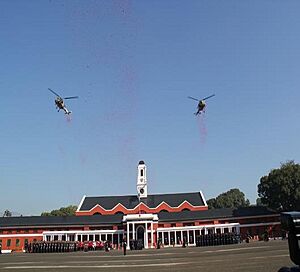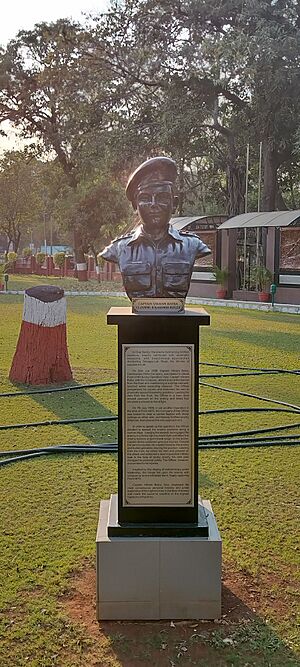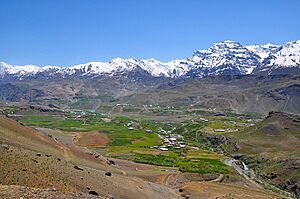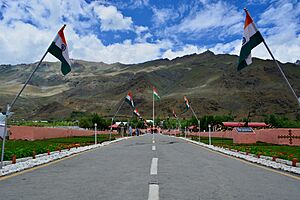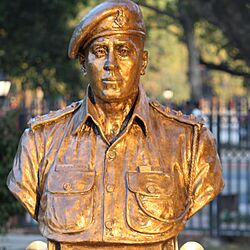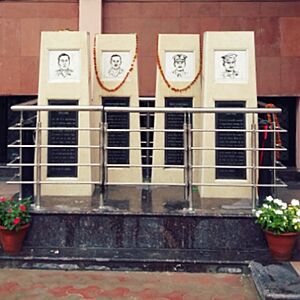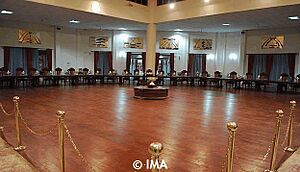Vikram Batra facts for kids
Quick facts for kids
Vikram Batra
|
|
|---|---|
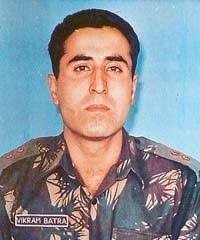
Official military portrait, 1997
|
|
| Born | 9 September 1974 Palampur, Himachal Pradesh, India |
| Died | 7 July 1999 (aged 24) Kargil, Jammu and Kashmir (now Ladakh) |
| Allegiance | |
| Service/ |
|
| Years of service | 1997–1999 |
| Rank | |
| Service number | IC-57556H |
| Unit | 13 Jammu And Kashmir Rifle |
| Battles/wars | Kargil War (1999) |
| Awards | |
| Alma mater |
|
Captain Vikram Batra, who received the PVC, was a brave Indian Army officer. He was born on September 9, 1974, and sadly passed away on July 7, 1999. He was given India's highest military award, the Param Vir Chakra, after he died. This award was for his amazing courage during the Kargil War. Captain Batra was killed while fighting Pakistani soldiers near Point 4875 in the Kargil district.
Contents
Early Life and School Days
Vikram Batra was born in a small town called Palampur, in Himachal Pradesh, India. His birthday was September 9, 1974. He came from a Punjabi Hindu family. His father, Girdhari Lal Batra, was a school principal. His mother, Kamal Kanta Batra, was also a teacher.
Vikram was the third of four children. He had an older brother and two sisters. He was also the older twin, born just 14 minutes before his brother, Vishal. Their mother, who loved the Hindu deity Rama, nicknamed them 'Luv' (Vikram) and 'Kush' (Vishal). These were the names of Rama's twin sons.
Vikram's first lessons were taught by his mother at home. Later, he went to D.A.V. Public School in Palampur. He then finished his senior secondary education at Central School in Palampur.
Besides his studies, Vikram loved sports. He played table tennis and Karate. He even represented his school at national competitions. In 1990, he and his twin brother played table tennis at the All India KVS Nationals. He also earned a green belt in Karate.
After finishing school in 1992, he went to DAV College, Chandigarh. There, he studied Medical Sciences. In his first year, he joined the Air Wing of the National Cadet Corps (NCC). He was chosen as the best NCC Air Wing cadet in Punjab. He even trained for 40 days in paratrooping. For the next two years, he was part of the Army Wing of NCC. He also led his college's Youth Service Club.
In 1994, he took part in the Republic Day parade as an NCC cadet. When he came home, he told his parents he wanted to join the Army. His grandfather had also been a soldier. In 1995, he had a chance to join the merchant navy. But he decided against it. He wanted to do "something great, something extraordinary, which may bring fame to my country." He finished his bachelor's degree that same year.
After college, in 1995, he joined Panjab University to study English. He wanted to prepare for the Combined Defence Services (CDS) Exam. He went to evening classes and worked part-time at a travel agency. In 1996, he passed the CDS exam. He was among the top candidates. After studying English for a year, he left the university to join the Indian Military Academy.
Joining the Army
Vikram Batra joined the Indian Military Academy (IMA) in Dehradun in June 1996. After 19 months of training, he became a lieutenant in the Indian Army on December 6, 1997. He joined the 13th battalion of the Jammu and Kashmir Rifles (13 JAK Rif). His first posting was in Sopore, Jammu and Kashmir. This area had a lot of militant activity.
In March 1998, he went to the Infantry School in Mhow for a five-month Young Officer's Course. He did very well in this training. He then returned to his battalion in Sopore in October 1998.
While in Sopore, Captain Batra faced militants many times. In one fight, a bullet meant for him hit and killed one of his men behind him. Batra ordered his soldiers to fire back. By morning, all the militants were killed. He believed the bullet was meant for him.
In January 1999, Batra went for a two-month Commando Course. He earned the highest possible grade.
He would often visit his home in Palampur when on leave. His last visit home was in 1999 during the Holi festival.
After his leave, he went back to Sopore. His battalion, the 13 JAK Rif, was supposed to move to Shahjahanpur. But on June 5, because the Kargil War started, their orders changed. They were told to move to Dras.
Captain Batra told his parents about the move. He told them not to worry. He called them often. His last phone call to his mother was on June 29, 1999.
He started as a lieutenant and was later promoted to the rank of Captain.
The Kargil War
Captain Batra's battalion, the 13 Jammu and Kashmir Rifles (13 JAK Rif), arrived in Dras on June 6. They were ordered to support another battalion, the 2nd battalion of the Rajputana Rifles (2 Raj Rif). This was during their attack on Tololing mountain. Another group, the 18th battalion of The Grenadiers, had tried to capture Tololing four times but could not. They suffered many losses. Finally, 2 Raj Rif captured Tololing on June 13, 1999.
After Tololing was captured, 13 JAK Rif marched for 12 hours to reach it. Captain Batra's company took over part of Tololing.
Capturing Point 5140
Captain Batra's battalion was given the job of capturing Point 5140 on June 17, 1999. After capturing a nearby area called Rocky Knob, the battalion's leader, Joshi, planned the attack on Point 5140.
On June 18, they carefully checked out Point 5140. Vikram Batra was put in charge of the Delta Company. During the planning, Vikram chose "Yeh Dil Mange More!" (This heart wants more!) as his signal for success. This was a famous advertising slogan at the time. The attack was set for June 19, at 8:30 PM.
After midnight on June 20, the two attack companies started climbing Point 5140. Artillery guns fired to prepare the way. The firing stopped when the soldiers were close to their target.
By 3:15 AM, both companies were near Point 5140. Batra decided to attack the hill from the back. This was to surprise the enemy and block their escape. Batra fired three rockets at the enemy bunkers. Then, he and his men climbed the steep rock-cliff. As they got near the top, enemy machine guns fired at them. Batra, with five of his men, climbed up. They threw two grenades at the machine gun post. Batra then bravely fought and killed three enemy soldiers by himself. He was badly hurt but kept leading his men. He charged at the next enemy position and captured Point 5140. His company killed at least eight Pakistani soldiers. They also found a heavy anti-aircraft machine gun. The remaining enemy soldiers ran away.
At 4:35 AM, Captain Batra radioed his command post. He said, "Yeh dil mange more!" They found a lot of weapons and ammunition. Neither of the Indian companies had any soldiers killed or injured in this battle. Capturing Point 5140 led to other successes, like capturing Point 5100 and Point 4700.
After this victory, Vikram Batra was promoted to Captain. The Chief of Army Staff, General Ved Prakash Malik, called to congratulate him. His success was shown on television all over India.
On June 26, 13 JAK Rif was ordered to rest. Then, on June 30, they moved to Mushkoh Valley.
Capturing Point 4875
Captain Batra's battalion's next mission was to capture Point 4875. On July 1, 1999, Major S Vijay Bhaskar and Lt. Col. Joshi planned the attack. Over the next two days, ammunition and heavy weapons were brought to a safe area about 1500 meters from Point 4875.
At 6:00 PM that day, artillery began firing at the enemy positions on Point 4875. This continued all night. At 8:30 PM, two companies started climbing Point 4875. Captain Vikram Batra was resting because he had a fever and was tired. His commanding officer had told him to rest.
Both attacking companies faced heavy sniper and machine gun fire from Pakistani soldiers hiding behind rocks. The attack was stopped.
At 4:30 AM, the two companies fired their automatic weapons at the enemy. Around 10:15 AM on July 5, the company commander told Lt Col Joshi about their problem. Joshi then fired two missiles, which destroyed the enemy position. The Indian troops started moving forward again. By 1:00 PM, they had captured Point 4875. However, they still faced enemy fire from other nearby areas.
The Indian victory also needed the capture of 'Area Flat Top', a nearby peak. 13 JAK Rif captured Flat Top on the afternoon of July 5 after a tough fight. But the enemy immediately counterattacked to get it back. Captain Nagappa bravely held Flat Top but was seriously injured. The Pakistanis started climbing faster.
Batra, who was watching from the base, volunteered to go help. His commanding officer didn't want him to go because he was unwell, but Batra insisted. Many soldiers from his battalion also volunteered to go with him.
Before leaving, Batra and 25 men from his Delta Company prayed at the Durga Mata temple. It was a very dark night when they started climbing. When Indian soldiers on top heard that "Sher Shah" (Batra's code name) was coming, they cheered. Their commander told them to hold their ground until Batra arrived.
Batra was still recovering from injuries he got at Point 5140. He wanted to reach the top to rescue his fellow soldiers. On the way up, Batra saw a Pakistani machine gun firing at the trapped Indian soldiers. He moved carefully, hiding behind rocks. When he got close, he threw a grenade, destroying the machine gun. Before dawn on July 7, his troops destroyed two more enemy machine guns. But firing from a ledge continued. Batra's group reached the ledge in daylight.
At 5:30 AM, Lt. Col. Joshi asked Batra to check the area. Batra, with two other officers, went to find a way to help their trapped soldiers. Batra found the enemy's machine gun position on the ledge. This machine gun was stopping his company's advance. Batra realized there was no easy way around. He decided to attack directly, even in daylight. Under heavy fire, Batra moved forward, shouting the battle cry of JAK RIF – Durga mata ki jai (Victory to Goddess Durga!). He charged the enemy position, firing his AK-47. He was badly injured but kept going. He reached the narrow entrance of the enemy position and surprised them. He killed five Pakistani soldiers in a close-quarter battle. This attack killed seven Pakistani soldiers. The Indians then gained a strong position on the ledge. The Pakistanis, surprised, started retreating. Batra and his men were winning. Batra pulled a bleeding soldier named Naveen from a bunker.
But there was still another enemy machine gun nest. Four Pakistani soldiers, including a junior officer, were manning it. Batra charged forward alone. He killed all four of them.
Batra then saw one of his men had been shot. He decided to help move him to safety. Batra exposed himself to enemy fire to drag the injured soldier. As he did this, an enemy sniper shot him in the chest from very close range. A moment later, a piece from a RPG hit him in the head. Captain Batra fell next to the injured soldier. He died from his serious wounds.
Param Vir Chakra Award
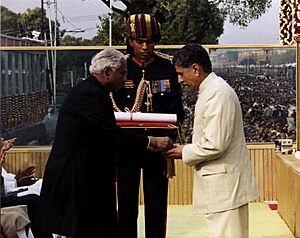
Vikram Batra was given the Param Vir Chakra, India's highest military honor, on August 15, 1999. This was the 52nd anniversary of India's independence. His father, G.L. Batra, received the award for his son from the President of India, K. R. Narayanan.
The Param Vir Chakra award description says:
AWARD DESCRIPTION
CAPTAIN VIKRAM BATRA
13 JAMMU AND KASHMIR RIFLES (IC 57556)
During 'Operation Vijay' on June 20, 1999, Captain Vikram Batra led his company to attack Point 5140. Captain Batra and his company moved around the hill from the east, surprising the enemy. They got close enough to attack. Captain Batra organized his team and encouraged them to attack the enemy positions. Leading from the front, he bravely attacked the enemy. He killed four of them in hand-to-hand combat. On July 7, 1999, in another mission at Point 4875, his company had to clear a narrow area with steep sides. The enemy had strong defenses covering the only way to it. To speed up the operation, Captain Batra attacked the enemy position along a narrow ridge. He fought fiercely in close combat and killed five enemy soldiers. Even though he was badly injured, he crawled towards the enemy. He threw grenades, clearing the position without caring for his own safety. Leading from the front, he gathered his men and pushed on the attack. He achieved a nearly impossible military task under heavy enemy fire. However, the officer died from his injuries. Inspired by his brave act, his troops attacked the enemy with great force. They destroyed them and captured Point 4875.
Captain Vikram Batra showed the most outstanding personal bravery and leadership in the face of the enemy. He made the ultimate sacrifice, following the highest traditions of the Indian Army.
Legacy and Memory
Captain Vikram Batra is famous in India for his slogan: Yeh Dil Maange More! He used this phrase to signal that a mission was successful. He was also known for saying that Pakistani soldiers knew about him.
Many places are named after him to honor his memory:
- The mountain Point 4875, which he bravely captured, is now called Batra Top.
- A hall at the Service Selection Centre Allahabad is named 'Vikram Batra Block'.
- A living area in the Jabalpur Cantonment is called 'Captain Vikram Batra Enclave'.
- The mess hall for cadets at the IMA is named 'Vikram Batra Mess'.
- His old college, DAV College, Chandigarh, has a memorial for war heroes, including Batra.
- Government College Palampur was renamed Shaheed Captain Vikram Batra Government College, Palampur.
- In December 2019, New Delhi's Mukarba Chowk and its flyover were renamed "Shaheed Captain Vikram Batra Chowk".
- The stadium at Palampur is named Saheed Captain Vikram Batra Stadium.
- Panjab University, Chandigarh, named a modern Indoor Shooting Range after Captain Vikram Batra.
The Indian Army honored Batra on the 21st anniversary of his death. They posted a video on social media. It featured his famous words, "Yeh dil mange more," and showed people saying, "I am Vikram Batra."
To mark 22 years since Batra's sacrifice, Army Commander Northern Command Lieutenant General Yogesh Kumar Joshi flew over "Batra Top" in a Sukhoi-30 MKI jet. He paid tribute to the hero from the sky. Joshi was also Captain Batra's commanding officer during the war.
A statue of Param Vir Chakra (PVC) Captain Vikram Batra was revealed at Palampur military station in 2022.
URF World Records (Universal Records Forum) recognized the largest underwater portrait of Batra. This was done on Kargil Vijay Diwas (July 26, 2022) at Pangode Military Station in Thiruvananthapuram, Kerala.
On Parakram Diwas, the Indian Government announced that 21 large unnamed islands in Andaman and Nicobar would be named after the 21 Param Vir Chakra awardees. Because he received the Param Vir Chakra, an island is named after Vikram Batra as Batra Island.


